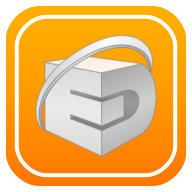


|

|
|
ICO (Favicon and Windows Icons) - Export ICO File format is a Windows file format used to store a family of images that are used as icons. This format is used for the Favicon in common use on the World Wide Web. A Favicon is a multi-resolution image included on nearly all web sites. The Favicon allows the browser to display a desktop or menu icon representing the web site. The multi-resolution aspect allows the icon image to be displayed optimally at 16x16 pixels up to 64x64 pixels. Different "color depths" can (and should) be included in the file, these allow the display application (operating system or browser) to draw with the preferred color model. Most Web browsers support the Favicon.ico file. If someone bookmarks a web site containing a favcion.ico file the icon is displayed beside the web site name in the menu system or windows managing user favorite sites. The icon is also commonly displayed next the site address in the main navigation entry field.
This export panel can be used to automatically generate a family of images from a vector drawing. More detailed control over the individual image generation is provided though the integration of individual layers. The popup menu just below the Include checkbox is used to select a particular image for inspection and interaction with the parameters of this panel. Use this menu to select an image format, then the individual parameters associated with this image are made available for interaction.
To add a favicon to your web site, export a drawing of your icon with the ico format. Upload the ico file to the root section of your web site. It is best to use the name: "FAVICON.ICO" for compatibility to all browsers. Open up index.html, and add this line after any meta tags in the HEAD section but before the </head> . <link REL="SHORTCUT ICON" HREF="http://yoursitedotcom.here/favicon.ico"> If you are in a user directory, without a domain, add something like this instead:
<link REL="SHORTCUT ICON" HREF="http://yoursitedotcom.here/yourdir/favicon.ico">
Example: If you owned www.stopupgrading.com , you would create the file favicon.ico, and FTP it to your host. Then, you'd use this code:
<link REL="SHORTCUT ICON" HREF="http://www.stopupgrading.com/favicon.ico">
Reload the page... and try adding it to your favorites or bookmarks. Once you've added it to the favorites, close the browser and then open it again, and return to the site. Does it show up now? It should. A rectangle with no stroke and no fill can be used to establish the size of the icon content. This technique will allow a border to be defined with the icon content enclosed within a defined rectangle. The stroke of the enclosing rectangle can be left on while drawing the icon, then turned off before exporting the file. If there is no defining bounding rectangle, the icon graphics are scaled up to fill the square defined by the export image specifications (i.e. 16x16 pixels). At the time of this writing it is advisable to avoid including the 32 bit true color formats in the ico file. Some applications may fail to handle this format properly. 16 and 256 color lists are the norm for use of this format. If possible, automatic color table generation (Best 16 or Best 256) should be used. This is true even if care was taken to only use a specific set of colors. The anti-aliasing algorithms will generate and use additional colors, for example at the transitions of a slanted line of pixels. This means that these additional colors would not be present in the specified color table, resulting in lower quality of the final saved image. Transparency is supported by the ICO format. Each image has a bit map and an associated bit mask. The areas defined by the bit mask are drawn with the bitmap image, the areas excluded by the mask are left transparent and not drawn. The 32 bit, alpha channel color form is not needed to provide image transparent backgrounds. EazyDraw automatically generates the transparency mask, any portion of the drawing that is not 100% opaque is defined as transparent in the included transparency mask. In most installations, the Color Lists are populated with pattern colors, this is the most common use for Color Lists on macOS. A list of color patterns can not be used with the bitmap format, as they are themselves bitmaps. The BMP format only supports RGB (Red, Green, Blue) color specifications. Any color list that contains at least one non-RGB color is disabled on the Color List Popup menu. This means that CMYK color lists may not be used too. When using 16 colors, as the BMP specification is defined, any 16 RGB colors is used. However, there is loosely defined default VGA set of 16 colors. It is probably wise to use this color list if possible. Many older applications may take short cuts, skip reading the embedded color list and use these VGA colors. EazyDraw builds and installs a Color List of the VGA colors, it is named: EZD_Windows16. |